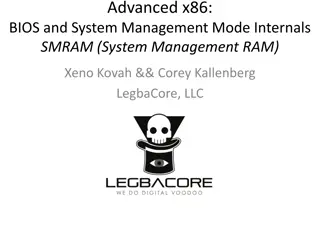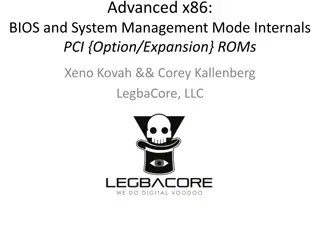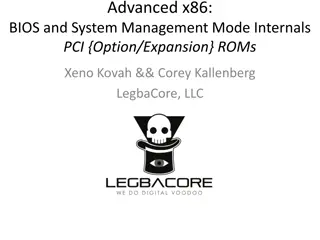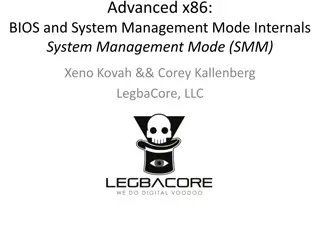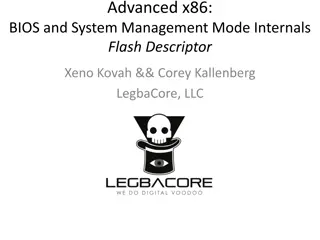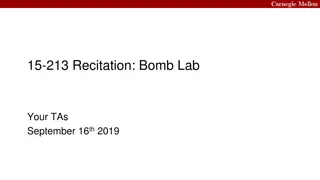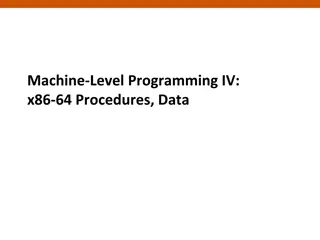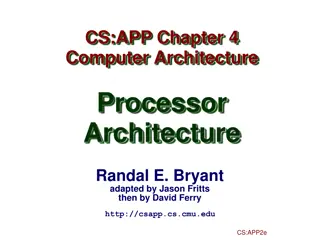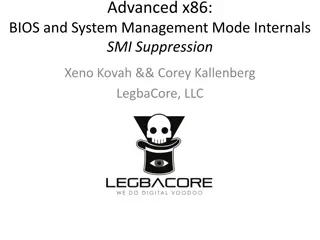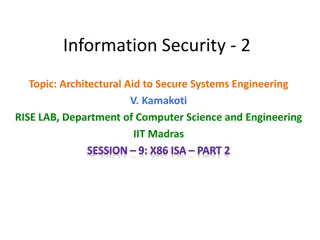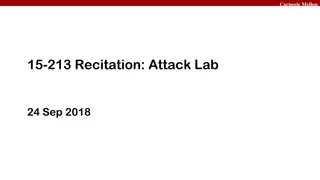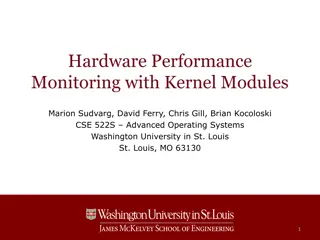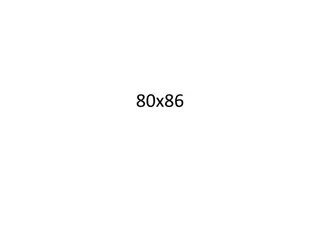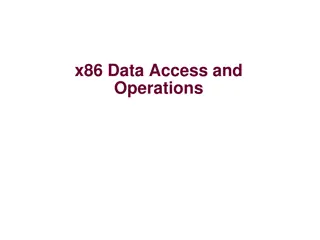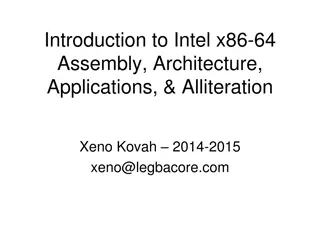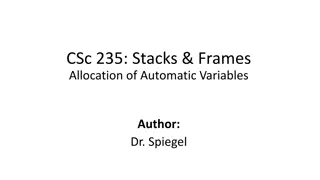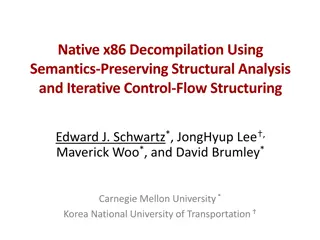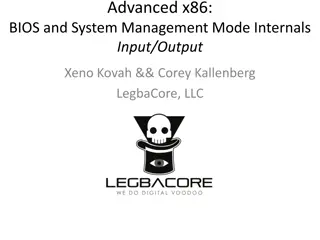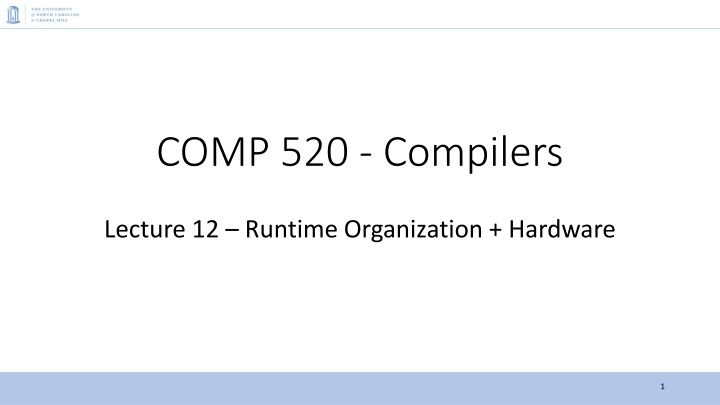
Assembly, Hardware, and CPU in COMP-520: Compilers Lecture Overview
Discover the basics of assembly, hardware, and CPU organization in the COMP-520: Compilers lecture series. Explore topics like simple hardware organization, modern CPU structure, and x86 assembly to deepen your understanding. Demystify hardware concepts and gain insights into ALU functionality.
Download Presentation

Please find below an Image/Link to download the presentation.
The content on the website is provided AS IS for your information and personal use only. It may not be sold, licensed, or shared on other websites without obtaining consent from the author. If you encounter any issues during the download, it is possible that the publisher has removed the file from their server.
You are allowed to download the files provided on this website for personal or commercial use, subject to the condition that they are used lawfully. All files are the property of their respective owners.
The content on the website is provided AS IS for your information and personal use only. It may not be sold, licensed, or shared on other websites without obtaining consent from the author.
E N D
Presentation Transcript
COMP 520 - Compilers Lecture 12 Runtime Organization + Hardware 1
Grades on Canvas I have added your grades to canvas. If something is missing or incorrect, let me know. If you turned in an assignment late, it is likely incorrect on canvas and I will fix it as soon as I can. 2 COMP 520: Compilers S. Ali
Todays Goals Be convinced that assembly, hardware, and the CPU in general is not magic 3 COMP 520: Compilers S. Ali
Todays Goals Be convinced that assembly, hardware, and the CPU in general is not magic First: Simple hardware organization (COMP-541) Second: Modern CPU organization (COMP-311) Lastly: x86 assembly 4 COMP 520: Compilers S. Ali
Goals Be convinced that assembly, hardware, and the CPU in general is not magic Not tested in this class, covered for your benefit First: Simple hardware organization (COMP-541/311) Second: Modern CPU organization (COMP-311) Lastly: x86 assembly 5 COMP 520: Compilers S. Ali
Goals Be convinced that assembly, hardware, and the CPU in general is not magic First: Simple hardware organization (COMP-541/311) Second: Modern CPU organization (COMP-311) Lastly: x86 assembly This will be VERY useful when working on PA4, covered for your benefit 6 COMP 520: Compilers S. Ali
Goals Be convinced that assembly, hardware, and the CPU in general is not magic First: Simple hardware organization (COMP-541/311) Second: Modern CPU organization (COMP-311) Lastly: x86 assembly This is PA4 7 COMP 520: Compilers S. Ali
Demystifying Hardware An extended commercial for COMP-541 8 COMP 520: Compilers S. Ali
Some coverage of the ALU In the interest of time, will only cover some parts of the ALU (Arithmetic Logic Unit) Specifically, let s cover the adder (where a subtracter is just a small, clever modification) Not Tested Material 9 COMP 520: Compilers S. Ali
What is 2s complement? Not Tested Material 10 COMP 520: Compilers S. Ali
What is 2s complement? Signed value (Two's complement) Bits Unsigned value 0000 0000 0 0 0000 0001 1 1 0000 0010 2 2 0111 1110 126 126 0111 1111 127 127 1000 0000 128 128 1000 0001 129 127 1000 0010 130 126 1111 1110 254 2 1111 1111 255 1 Not Tested Material 11 COMP 520: Compilers S. Ali
Motivation: Example Goal Add the following: 0000 0101 + 0000 1101 Not Tested Material 12 COMP 520: Compilers S. Ali
Lets first focus on single bit addition 0 + 0 0 + 1 1 + 0 1 + 1 Not Tested Material 13 COMP 520: Compilers S. Ali
Lets first focus on single bit addition 0 + 0 0 0 + 1 1 1 + 0 1 + 1 Not Tested Material 14 COMP 520: Compilers S. Ali
Lets first focus on single bit addition 0 + 0 0 0 + 1 1 1 + 0 1 1 + 1 10? Not Tested Material 15 COMP 520: Compilers S. Ali
1+1 Gets an entire slide! Let s rewrite this: 1+1 = 0 (carry 1) Not Tested Material 16 COMP 520: Compilers S. Ali
Lets first focus on single bit addition 0 + 0 0 c0 0 + 1 1 c0 1 + 0 1 c0 1 + 1 0 c1 Not Tested Material 17 COMP 520: Compilers S. Ali
Motivation: Example Goal Add the following: 0000 0101 + 0000 1101 0c1 c1 Not Tested Material 18 COMP 520: Compilers S. Ali
Lets first focus on single bit addition 0 + 0 + c1 1 c0 0 + 1 + c1 1 + 1 + c1 Not Tested Material 19 COMP 520: Compilers S. Ali
Lets first focus on single bit addition 0 + 0 + c1 1 c0 0 + 1 + c1 0 c1 1 + 1 + c1 1 c1 Not Tested Material 20 COMP 520: Compilers S. Ali
Motivation: Example Goal Add the following: 0000 0101 5 + 0000 1101 +13 0001 0010 18 Not Tested Material 21 COMP 520: Compilers S. Ali
Can we come up with something more formal? What does this look like in hardware? 22 COMP 520: Compilers S. Ali
Truth Tables (COMP-283) ? ? ??? ? ???? 0 0 0 0 0 0 1 0 1 0 1 0 0 1 0 1 1 0 0 1 0 0 1 1 0 0 1 1 0 1 1 0 1 0 1 1 1 1 1 1 Not Tested Material 23 COMP 520: Compilers S. Ali
Truth Tables (COMP-283) ? ? ??? ? ???? 0 0 0 0 0 0 1 0 1 0 1 0 0 1 0 1 1 0 0 1 0 0 1 1 0 0 1 1 0 1 1 0 1 0 1 1 1 1 1 1 If odd number of 1s: S=1, otherwise S=0 What is the boolean logic look like? Not Tested Material 24 COMP 520: Compilers S. Ali
Truth Tables (COMP-283) ? ? ??? ? ???? 0 0 0 0 0 0 1 0 1 0 1 0 0 1 0 1 1 0 0 1 0 0 1 1 0 0 1 1 0 1 1 0 1 0 1 1 1 1 1 1 ? = ??? ? ? Where exclusive or Not Tested Material 25 COMP 520: Compilers S. Ali
Adder Boolean Algebra ? = ??? ? ? ????= ??? A ? A B And what can we do with boolean algebra? Not Tested Material 26 COMP 520: Compilers S. Ali
Single Bit Adder A B C A B A B C S ???? Not Tested Material 27 COMP 520: Compilers S. Ali
1-Bit Adder A B ??? ???? S Not Tested Material 28 COMP 520: Compilers S. Ali
4-Bit Adder Coming Soon! ?3 ?3 ?2 ?2 ?1 ?1 ?0 ?0 CF ?3 ?2 ?1 ?0 Not Tested Material 29 COMP 520: Compilers S. Ali
Adder Input/Output A=0000 0101 5 +B=0000 1101 +13 S=0001 0010 18 Where 18= Where 18= ??+ ???+ ???+ Aka, Aka, ? = ??? ?? Not Tested Material 30 COMP 520: Compilers S. Ali
Thus, Hardware IS NOT IS NOT Magic Addition is not magic, it is simple simple circuitry But it would be a stretch to say that the rest of the hardware follows similarly If you are curious, see COMP-541 Not Tested Material 31 COMP 520: Compilers S. Ali
CPU Organization 32 COMP 520: Compilers S. Ali
Cache Hierarchy L1 Cache: Paper on Desk L2 Cache: Go to bookshelf L3: Go to local library RAM: It s in another library in North Carolina 33 COMP 520: Compilers S. Ali (Credit: J. H. Anderson)
Storage access time 1) Head to the North Atlantic Ocean 2) Sail to London 3) Go to Oxford 4) Wait in line for the Oxford English dictionary, make copies of what you need 5) Sail back 34 COMP 520: Compilers S. Ali (Credit: J. H. Anderson)
Thankfully, Memory is Memory From the perspective of the machine code, accessing memory looks the same (not counting page faults, for that, see COMP-530 and 630 to implement it) This means we don t consider where memory is in cache to be relevant when writing machine code All handled by the hardware to be nearly invisible 35 COMP 520: Compilers S. Ali
So what types of memory DO we worry about? Stack Heap Segments: .text (Executable section) .bss (Uninitialized static data) .data (Initialized static data) We will discuss .idata and other segments later 36 COMP 520: Compilers S. Ali
Data Segment Consider static elements such as: class A { private static int a private static String b } int a = 0; String b = Hello World ; 37 COMP 520: Compilers S. Ali
Variable data known before runtime private static int a private static String b int a = 0; String b = Hello World ; So instead of having to do an initialization step: Store 0 at data 0x5000 , Store Hello World\0 at data 0x5004 38 COMP 520: Compilers S. Ali
Variable data known before runtime private static int a private static String b int a = 0; String b = Hello World ; So instead of having to do an initialization phase: Store 0 at data 0x5000 , Store Hello World\0 at data 0x5004 Just store the raw data directly! 39 COMP 520: Compilers S. Ali
XVI32 Example If you open an executable file in notepad 40 COMP 520: Compilers S. Ali
XVI32 Example Various Strings The number 1, and 15 41 COMP 520: Compilers S. Ali
Idea: Take chunk of data and load it in memory Chunk of data ( .data ) in executable: int a = 4; int b = 5; String c = Hello ; in the same ordered form, s.t., MemPos+0x00 = int a MemPos+0x08= String c MemPos+0x04 = int b And when our program is running, it sees this data 42 COMP 520: Compilers S. Ali
Uninitialized Memory (.bss) Static memory that is initialized to zero Described by a single number usually 43 COMP 520: Compilers S. Ali
Uninitialized Memory (.bss) Static memory that is initialized to zero Described by a single number usually I need 4096 bytes of data initialized to zero static int a; static int b; static String c; None initialized. Respectively, positions: .bss+0, .bss+4, .bss+8 will contain our variables a, b, c. 44 COMP 520: Compilers S. Ali
Planning! Before we talk about .text, stack, and heap, we will first talk about some x86 basics 45 COMP 520: Compilers S. Ali
x86-64 Basics 46 COMP 520: Compilers S. Ali
Instructions Each command that you issue to a processor is an instruction. For example, store this variable there or load this data . Each instruction is a very simple operation. 47 COMP 520: Compilers S. Ali
Register File Lots of registers, but here are the 6 general purpose registers that we are concerned with: rax, rcx, rdx, rbx, rsi, rdi 48 COMP 520: Compilers S. Ali
Registers are like variables That s right, we re pretty much going to do everything simple in 6 registers, and a few extra registers for additional functionality 49 COMP 520: Compilers S. Ali
Instructions Location? The serialized instructions are contained in a .text segment. Not always called .text, but we will refer to the .text segment with the assumption that it is the relevant executable segment. 50 COMP 520: Compilers S. Ali

